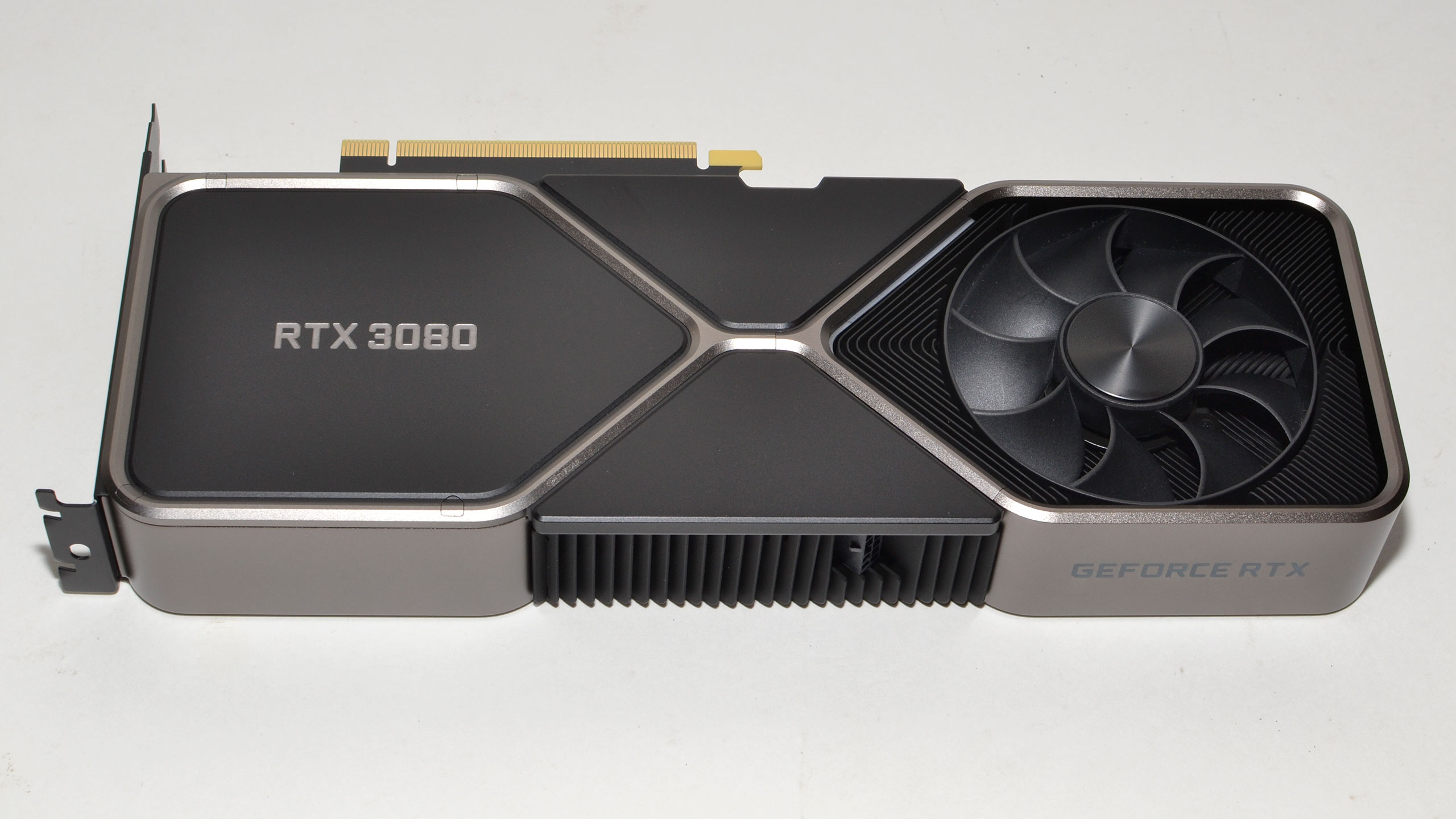Why you can trust Tom's Hardware
We won't belabor the point, but without ray tracing and/or DLSS, most games simply don't benefit much from the performance the RTX 3080 delivers. We'll skip the individual gaming charts and just show the overall averages:
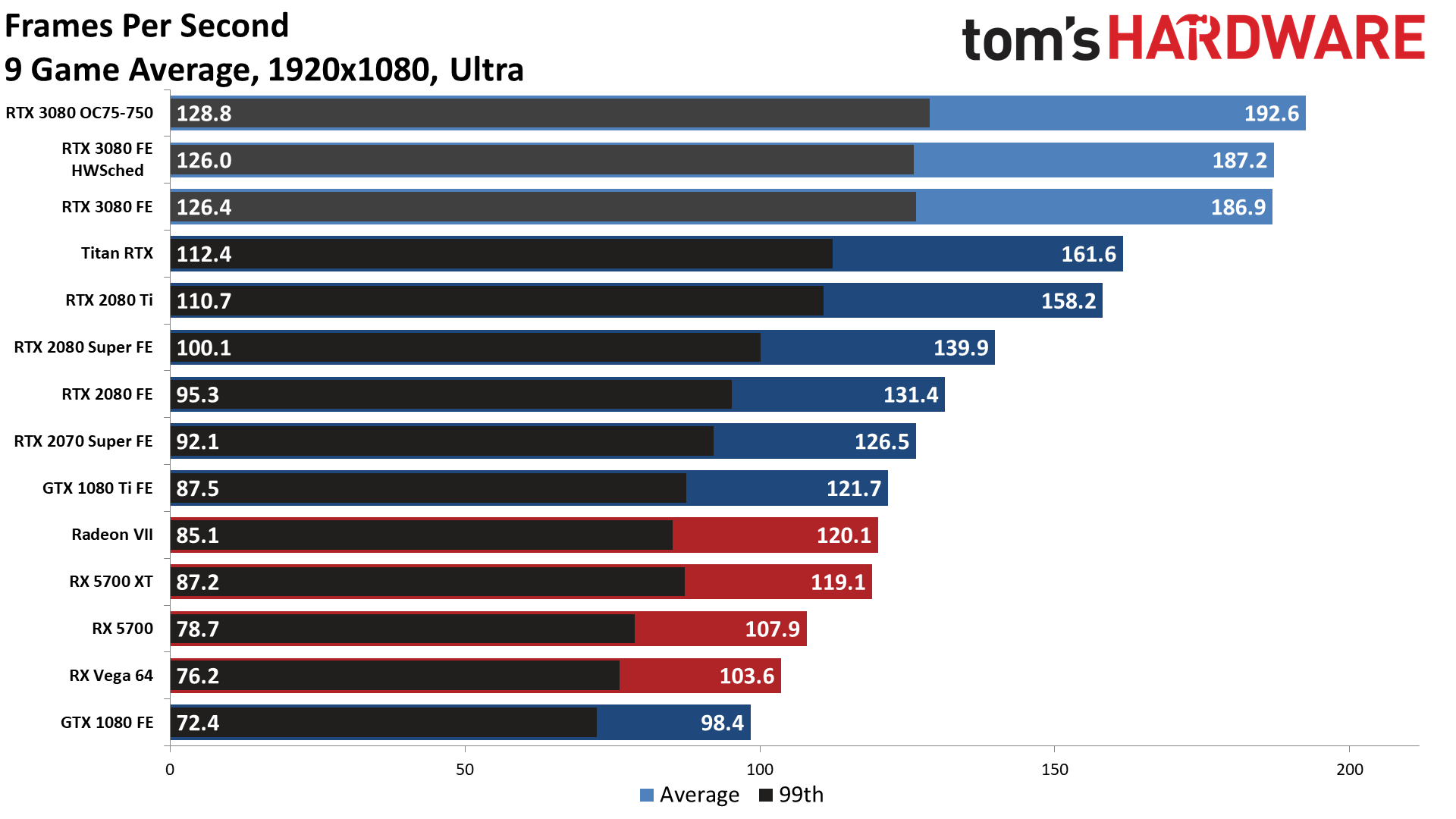
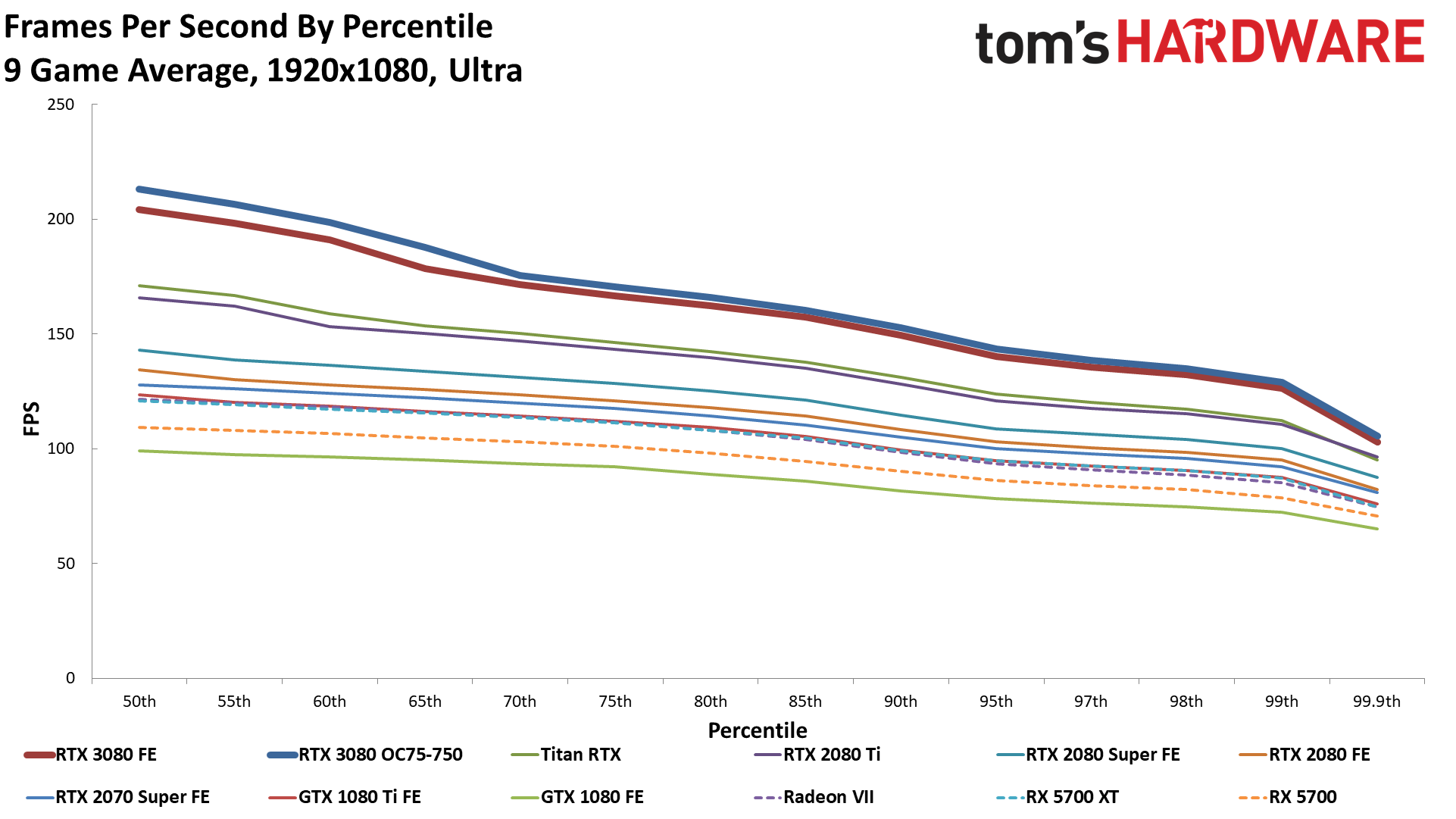

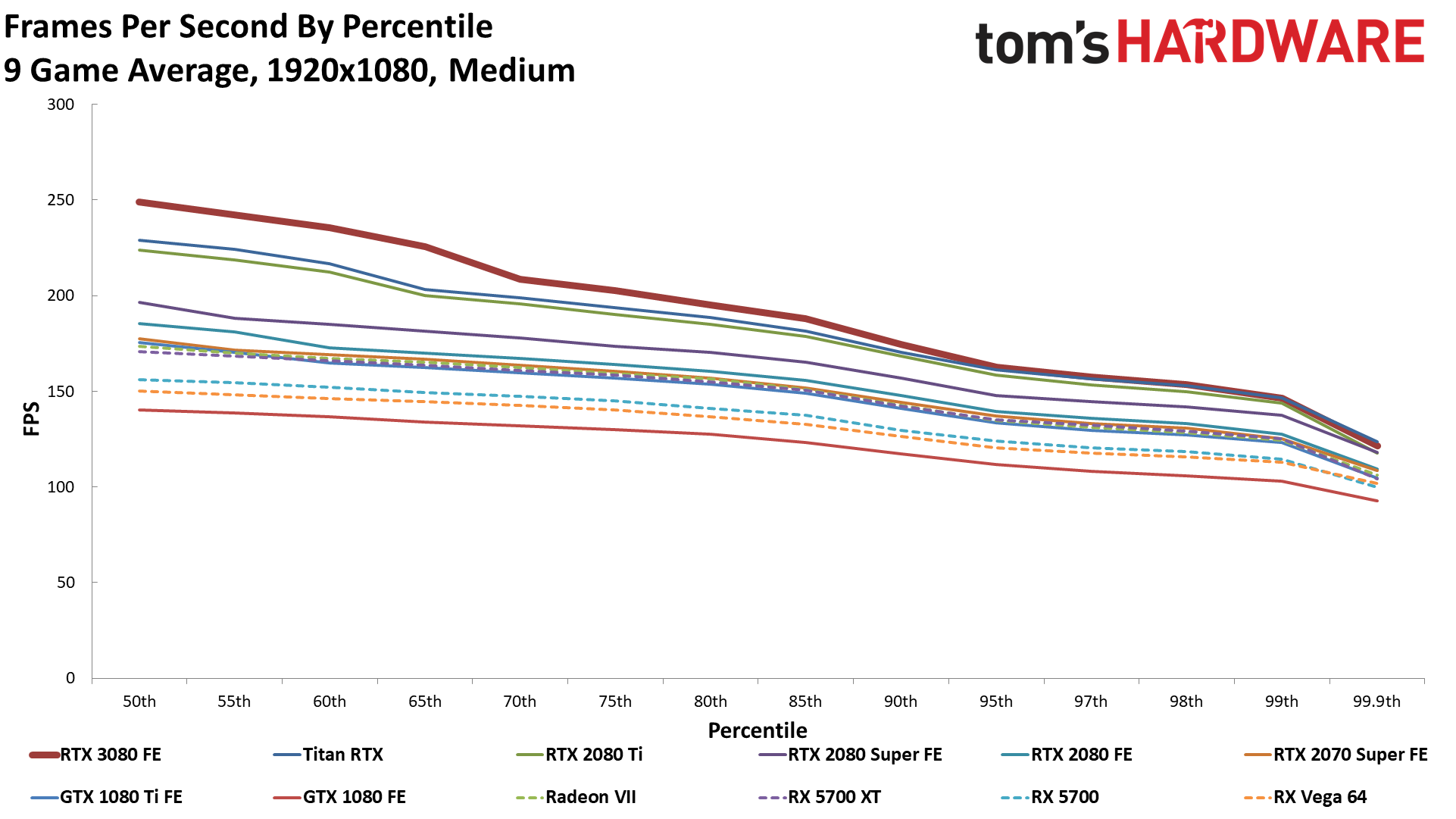
If you want to use the RTX 3080 to play at 1080p ultra, it's now only 18% faster than the RTX 2080 Ti. Or rather, the CPU and other elements aren't able to keep up with the 3080, so it putters along admiring the view and enjoying a relaxing stroll down 1080p lane. And if you want to take things a step further, it was only 8% faster than the RTX 2080 Ti at 1080p medium — and there were a few instances where the older GPU actually came out ahead (likely thanks to better optimizations in the games for the existing Turing architecture).
Speaking of which, it's worth noting that since the Ampere architecture is brand new, games and drivers are unlikely to be fully optimized for it right now. It's unlikely that existing games will see patches to improve performance on Ampere. Still, Nvidia has a history of getting at least 5-10% more performance from its latest architecture with driver updates. It's not guaranteed by any means, but we do expect the RTX 3080's lead over the RTX 2080 to increase somewhat over the coming months.
GeForce RTX 3080: Bonus 4K Ultra Gaming Benchmarks
Which is a great segue into our bonus gaming and graphics benchmarks. We tested the RTX 3080, RTX 2080 Ti, and RTX 2080 FE on 14 additional games and graphics tests, many of which utilize ray tracing and/or DLSS. We only tested at 4K and ultra settings or equivalent, except for 3DMark Port Royal, which runs at 1440p. Here are the results:


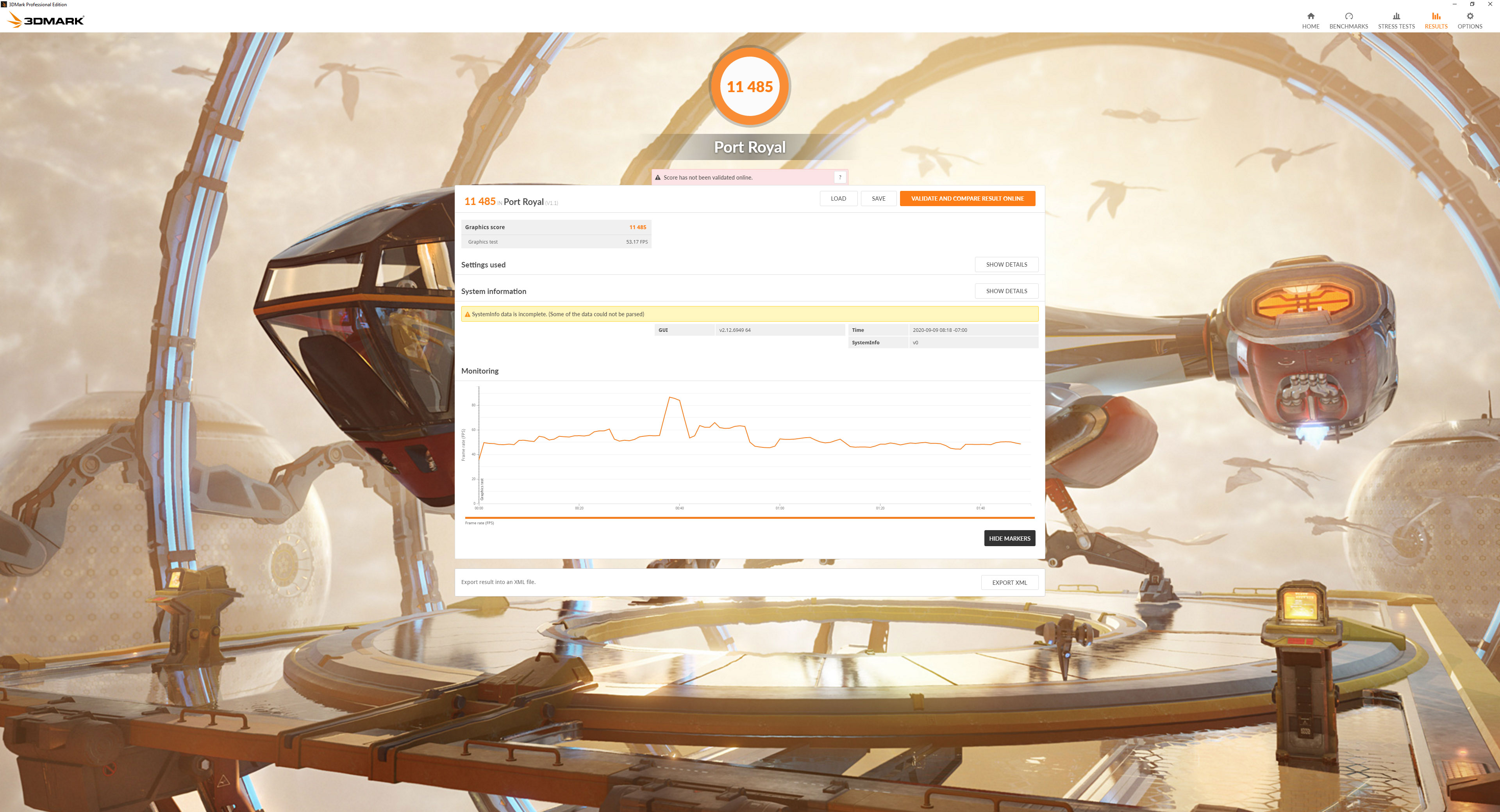
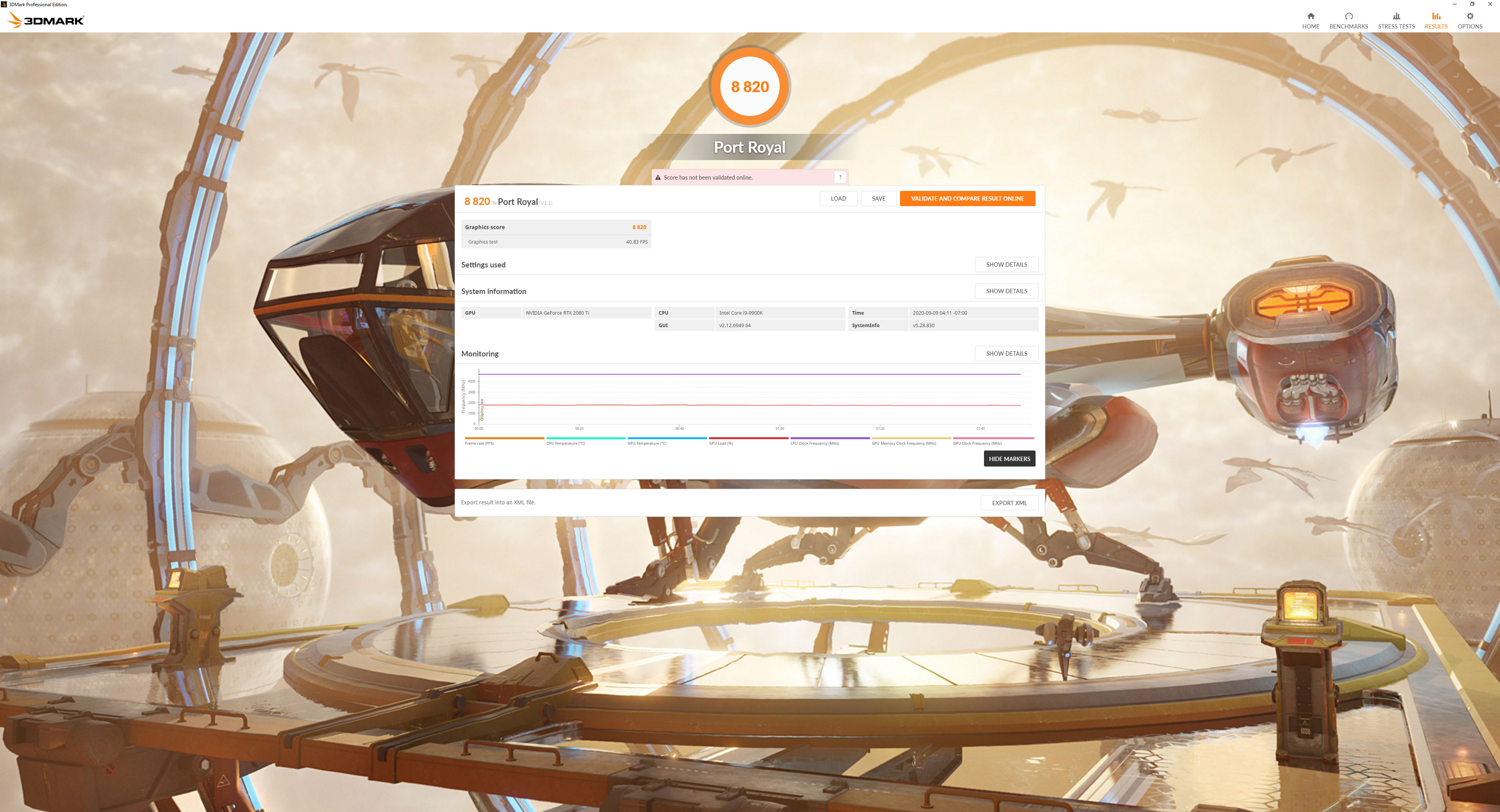




We'll start with the overall average again, where we take the average fps of all fourteen games and graphics tests. (Yeah, it says 14 games, but we're just trying to make the chart title not look huge.) We ran some of the tests at multiple settings and included all results in the average. It's interesting that, even with an almost completely different selection of games and benchmarks, the RTX 3080 FE ends up with a nearly identical lead at 4K ultra.
In our primary nine-game suite, the RTX 3080 FE was 32% faster than the RTX 2080 Ti and 69% faster than the RTX 2080 FE. For these 14 tests, the RTX 3080 FE was … wait for it! … 32% faster than the 2080 Ti and 70% faster than the RTX 2080 FE. And trust me, I don't have time to pick and choose benchmarks to try and skew things for that result. I just grabbed a bunch of recent games and some new ray tracing benchmarks that are available and threw them at these GPUs, and it proves that the overall view is basically correct. You gotta love statistics. (Okay, you don't, but it's great when it all works out so nicely.)
Let's dig into the various benchmarks and look at the individual results.
Get Tom's Hardware's best news and in-depth reviews, straight to your inbox.


3DMark Port Royal reports an overall score, but we used OCAT to log frametimes instead so that we can generate percentile charts and minimum fps results. I also tested Time Spy but didn't bother with gathering frametimes — it's not included in the overall average. You can see the 3DMark images above (the unnamed CPU/GPU results are for the 3080, which 3DMark's System Info utility failed to identify).
As for performance, Port Royal averaged 53 fps, even though it's running at 1440p. That might seem low, but it does use a lot of ray tracing effects and the benchmark doesn't use DLSS for upscaling. By percentages, the 3080 was 30% faster than the 2080 Ti and 75% faster than the 2080. Relying on any single benchmark as a universal determination of performance is liable to lead to cheating and gaming the system, though, so even though Port Royal is only off by 2-5% from our overall metric, it's best to keep using lots of tests. (Incidentally, Time Spy only gives the 3080 a 21% lead over the 2080 Ti, and 51% over the 2080 FE.)


Next up, Battlefield V with DirectX Raytracing (DXR) reflections and with DLSS enabled. This is a DLSS 1.0 game, and it's also the first game to get RTX enhancements. We ran around the Nordlys mission, where there are lots of puddles that provide shiny reflections. It's not as demanding as some of the other levels, or as multiplayer mode, but it's at least repeatable. Here, the 3080 is only 23% faster than the 2080 Ti and 52% faster than the 2080 FE.
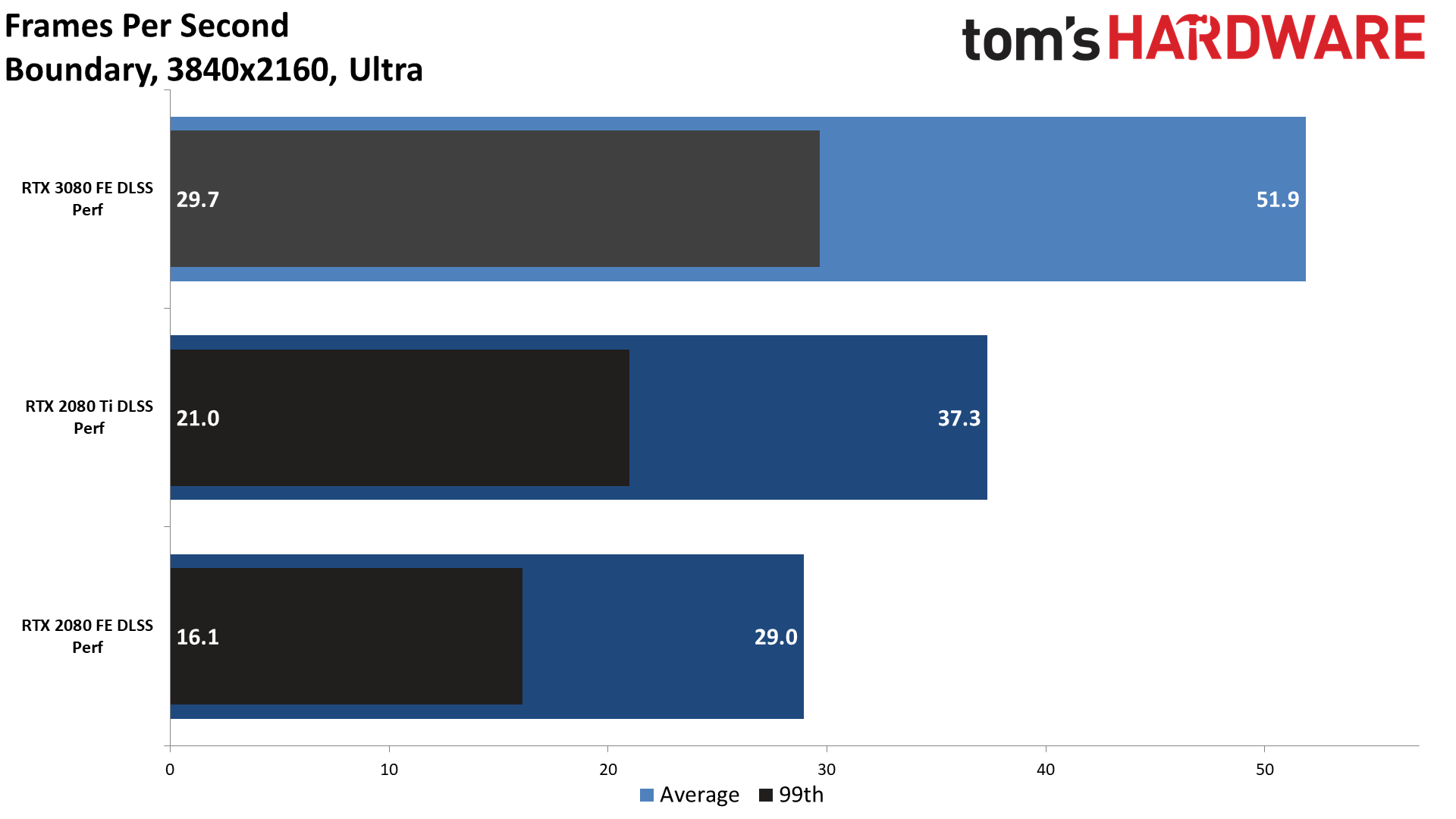
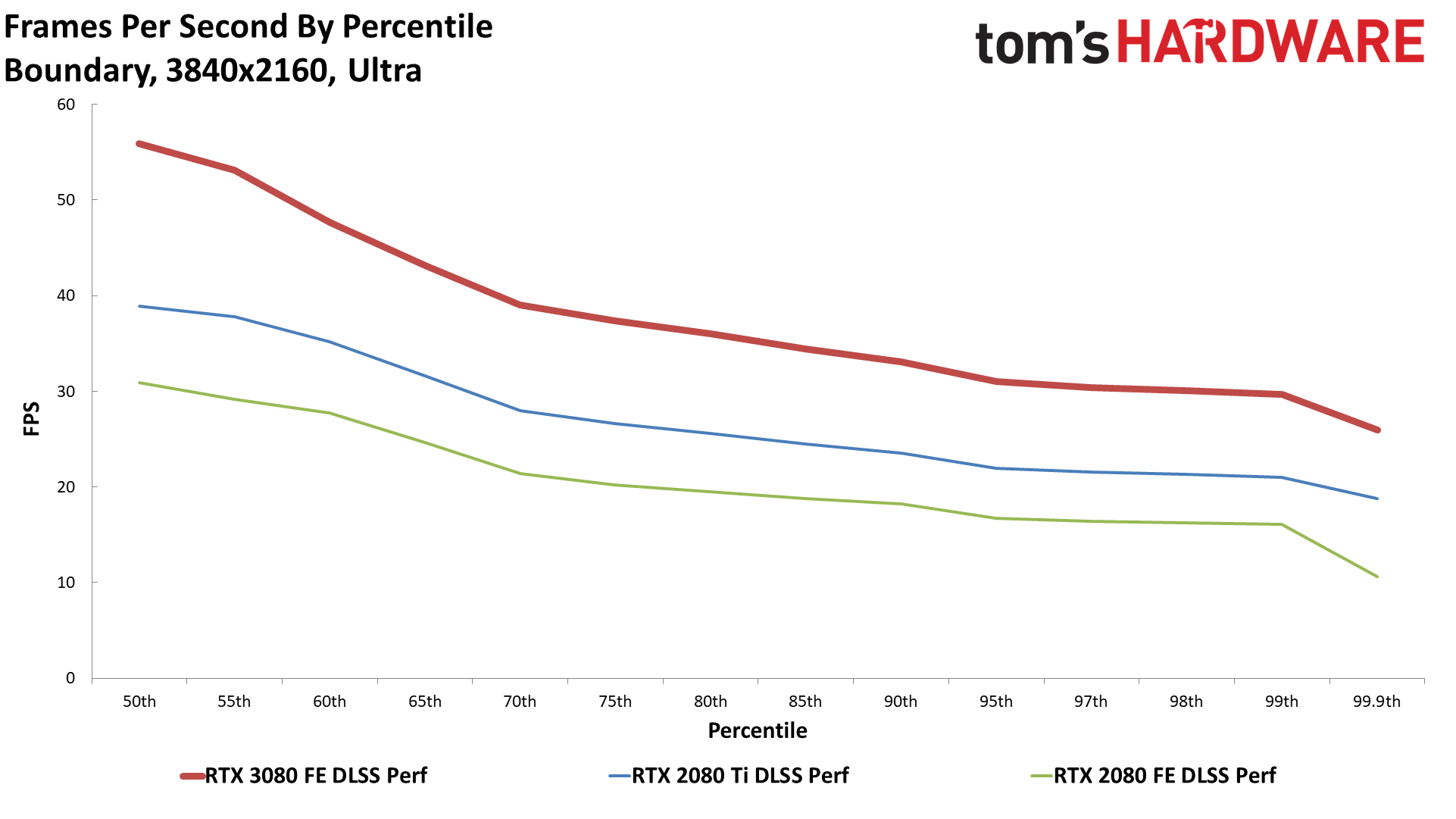
The Boundary Benchmark is a new one from Chinese developers Studio Surgical Scalpels, and it includes lots of ray tracing effects: global illumination, reflections on opaque and translucent surfaces, shadows, and ambient occlusion. It also supports DLSS in performance, balanced, and quality modes, but since we were running at 4K, we just stuck with the performance option. Even then, frame rates were below 60 fps on the 3080, and just 29 fps on the 2080. This is a great example of what a next-generation ray tracing enhanced game engine might look like, and it shows that even with twice the ray tracing performance of Turing, games are going to be able to tax even Ampere GPUs if they want to.


Bright Memory Infinite is another benchmark from Chinese developers FYQD-Studio — they actually plan to make it a full game on Steam, though it's not finished yet. Like the Boundary benchmark, it includes basically all the ray tracing options, including some we haven't seen before in other games. Reflections, refractions, shadows, ambient occlusion, order-independent transparency (OIT), and caustics. It also uses multiple-bounce rays at higher settings, which makes for more realistic reflections and refractions at the cost of performance. It has four presets, and we tested using the high and very high options, which also necessitated using DLSS 2.0 in performance mode (1080p upscaled to 4K).
The high preset uses low-resolution caustics, five bounce refractions, one bounce reflections, OIT, AO, and shadows from up to three light sources. Very high kicks things up another notch with high-resolution caustics, six bounce refractions, two bounce reflections, OIT, AO, and ray tracing for "all" light sources. Either way, the images are damn impressive and show what ray tracing games of the future could bring to the party. Performance was similar to Boundary when using the very high preset on the 3080, but the 2080 and 2080 Ti were a bit slower; the high preset runs better and nearly reaches 60 fps on the 3080.


Control was the first game to push more than one major ray tracing effect, with reflections, diffuse lighting, transparent reflections, and ambient occlusion. It was also one of the first implementations of DLSS 2.0, but actually showed the rendered resolution rather than using nebulous "quality, balance, performance" labels. The 2080 Ti could just barely manage to average 60 fps with all the RT effects enabled, using 1080p upscaling to 4K. The 3080 FE can basically match that level of performance with 'quality' 1440p upscaling, or perform 40% faster than the 2080 Ti with 1080p upscaling. The 3080 is also 81% faster than the 2080 FE.


Death Stranding already ran quite well at 4K ultra settings with even a 2080 using the DLSS quality preset, so we didn't bother with lower DLSS levels. It's already a bit CPU limited, but it's a great showcase for how DLSS 2.0 can look better than native rendering — mostly because the native rendering uses temporal AA and tends to blur things too much. Anyway, it looks good, and if you like hiking around a weirder than snot representation of post-apocalyptic USA, you can now do so at over 120 fps — perfect for playing on a 4K 120Hz LG OLED TV!


Doom Eternal is our second Vulkan game, and like Strange Brigade, performance is very good across all three GPUs we tested. We did a full Doom Eternal performance analysis back when the game launched, and patches and driver updates have improved performance even more since then. There's no fancy ray tracing or DLSS effects in the game (even though it was originally on the list of games that were planning to add ray tracing when Turing launched), but you do get 171 fps on the 3080 at 4K ultra nightmare settings. Oh, and the RTX 3080 is more than twice as fast as the RTX 2080 for a change — one of the only cases where we measured such an increase in performance.
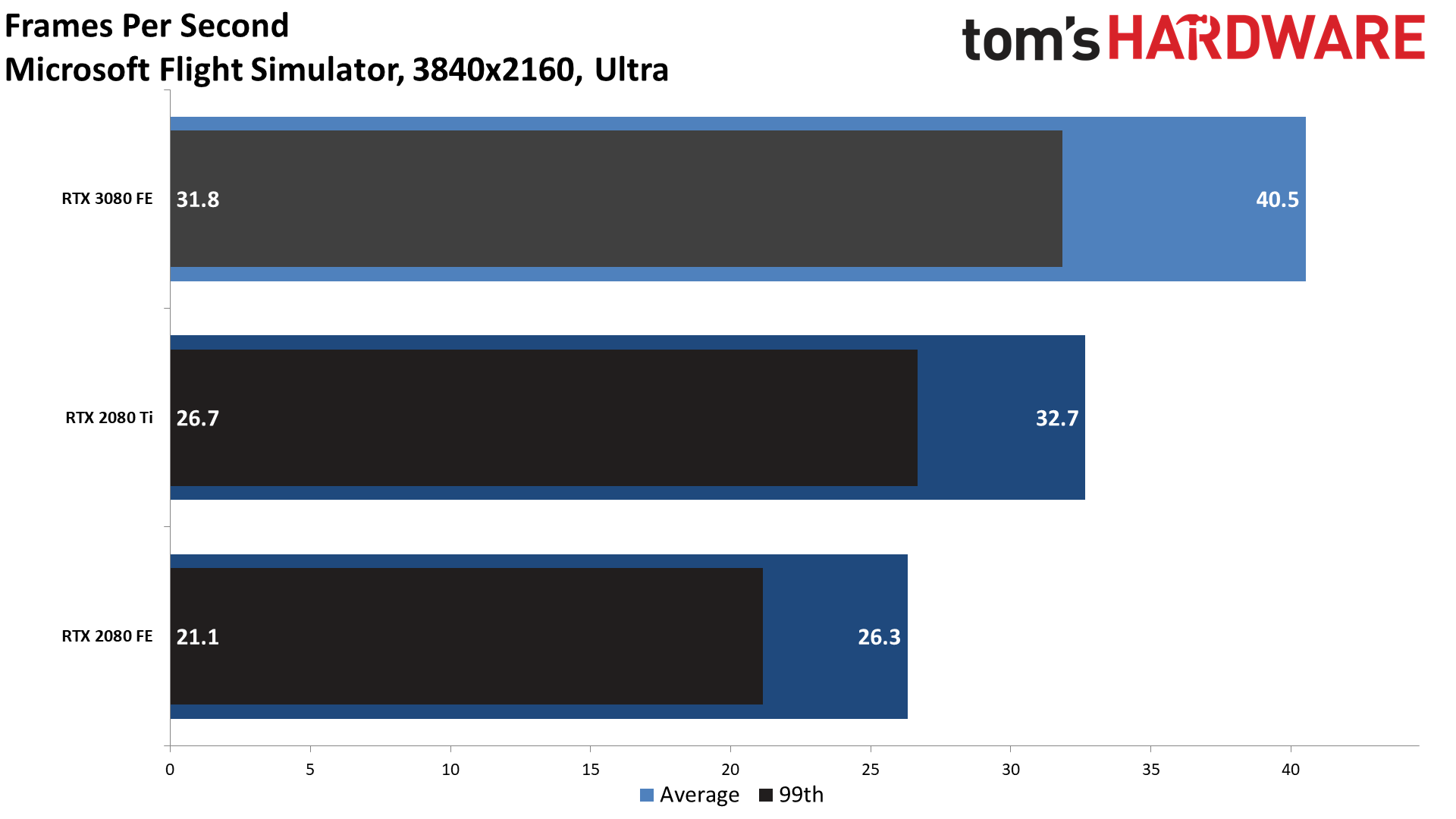

We recently did a full performance analysis of Microsoft Flight Simulator 2020 and found it to be a game that taxes CPUs more than anything else currently available. Also, it uses DirectX 11 and appears to be severely hampered by draw call limitations. Anyway, we wanted to see how the 3080 handled 4K ultra, bearing in mind the ultra preset basically maxes out at around 51 fps on our Core i9-9900K test PC. The result is better than the RTX 2080 Ti by 24%, and 54% higher than the 2080, but you'd be better off dropping a few settings (as we cover in the MSFS 2020 benchmarking article).

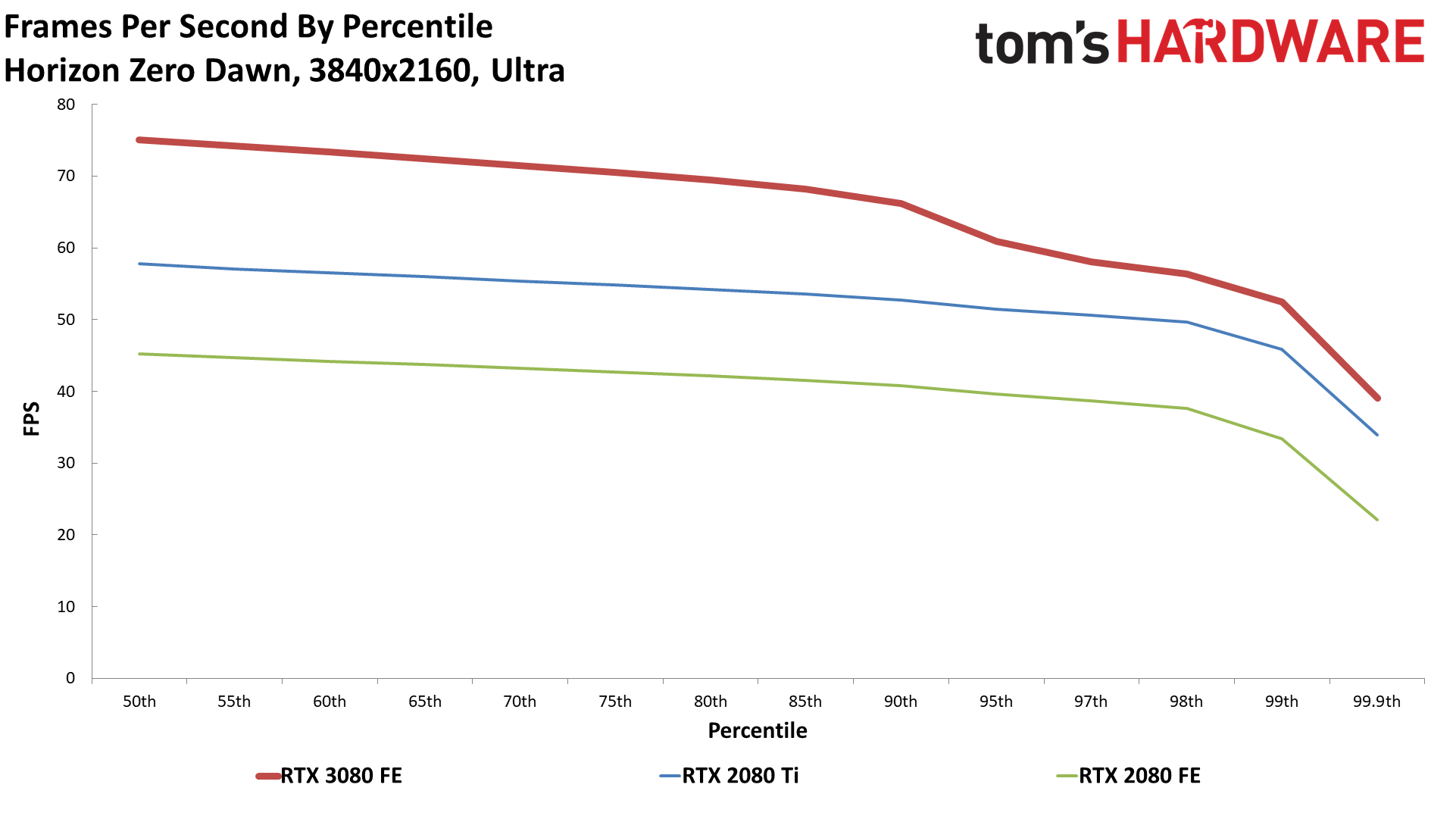
Similar to Death Stranding, Horizon Zero Dawn is another Sony PlayStation 4 game recently ported over to PC. Despite using the same engine, it doesn't run as well — and there's no DLSS support either. In terms of performance, however, it ends up within 1% of our overall averages. Also, 4K ultra easily sails past 60 fps now, which wasn't possible without dropping the settings on the 2080 Ti.
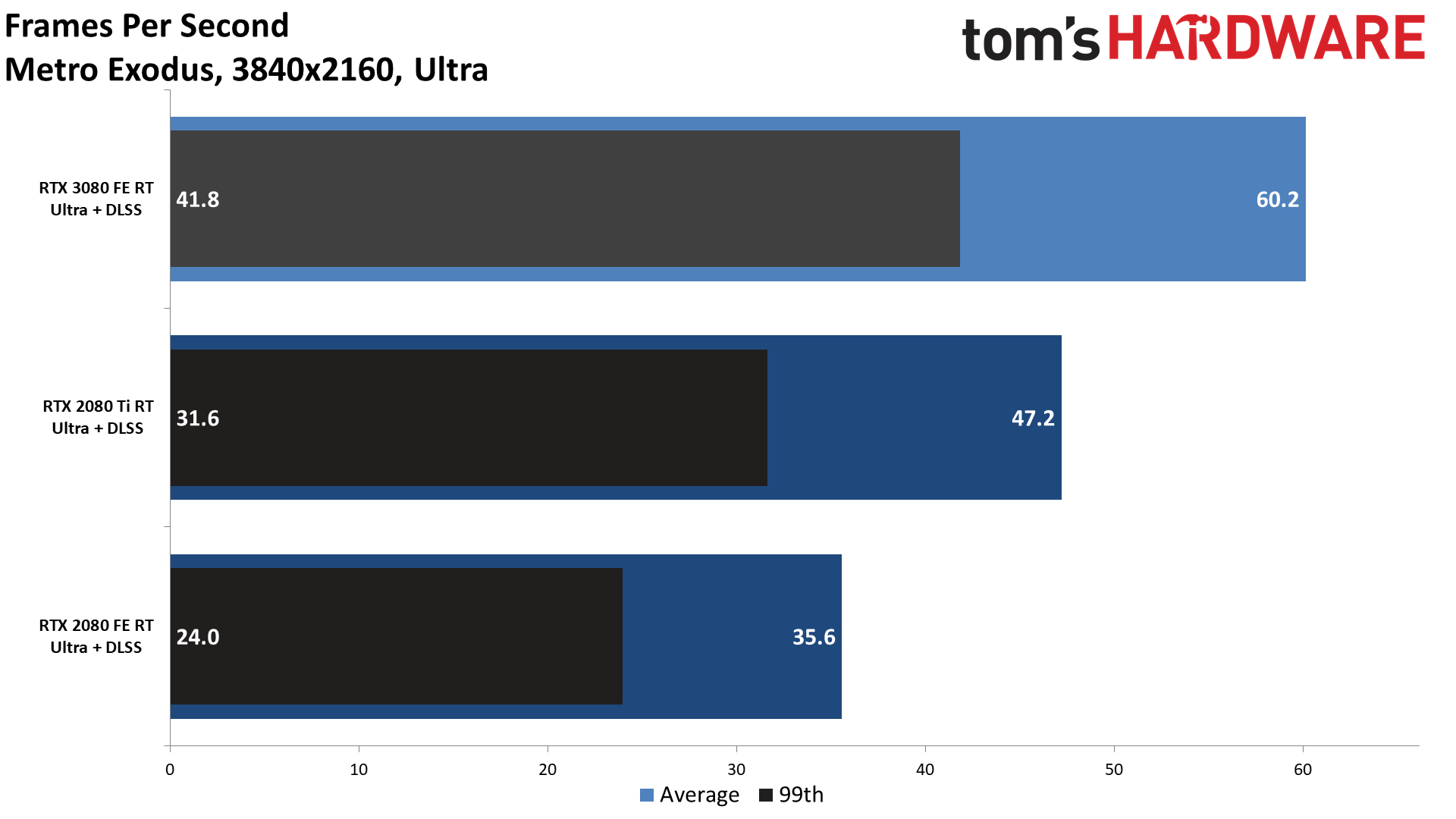

We already benchmark Metro Exodus without ray tracing or DLSS enabled, but we also wanted to try getting the full experience. RTX 2080 Ti couldn't come close to 60 fps before, and even the RTX 3080 still barely averages 60 fps, with frequent dips into the 40-50 fps range. The good news is that you could tweak the settings a bit to improve performance — or maybe plunk down $1,500 on an RTX 3090 next week? Hmmm.


Call of Duty Modern Warfare ran well enough at 4K ultra with ray tracing shadows enabled that the developers didn't feel a need to support DLSS. Not that it really matters since this is primarily a multiplayer game, and most multiplayer gamers aren't going to worry about tanking framerates for realistic shadows. Relative performance is once again quite close to our overall metric.


Project CARS 3 recently launched, and we've used the previous version for our CPU reviews, so we thought we'd check out the new update. It ended up being more CPU-limited than other games and lacks some major options like post-process anti-aliasing. Still, even the RTX 2080 clears 60 fps, while the RTX 3080 comes close to 100 fps.


Shadow of the Tomb Raider was cleverly named, what with the introduction of ray-traced shadows. Except the patch that added the DXR effect only arrived many months after the game's 2018 release, when most gamers had probably moved on. Still, we use it as a benchmark, and enabling the DXR shadows can drop performance quite a bit. It also supports DLSS, which we enabled, but it's DLSS 1.0 (aka, the not as good version of DLSS).


Last in our list of bonus benchmarks, Wolfenstein Youngblood also belatedly added ray tracing and DLSS support months after its release. It only does ray-traced reflections, but it also uses the Vulkan API. So far, Vulkan games have tended to perform better than DX12 games, but that might be the developers rather than the API. Anyway, Youngblood is interesting in that the RTX 3080 can run with DLSS Quality mode and still outperform the RTX 2080 Ti in DLSS Performance mode. It can also break 144 fps on the 3080 using DLSS performance mode if you have a high refresh rate monitor.
GeForce RTX 3080: Mining Performance and Compute Benchmarks
Remember how we said we weren't done with benchmarks yet? Well, this is one area where we have a few more tests we want to run. We'll update this over the coming days with additional testing. We also plan to run the Blender GPU benchmark, and we're looking at some other potential options.
We did want to check one item off the list, though: cryptocurrency mining performance. There were rumors that the RTX 3080 can hit 120 MHash in Ethereum mining, which is nearly triple what you can get from a 2080. That would potentially make this a profitable and desirable mining solution. We grabbed NiceHashminer and ran the benchmark mode, which failed on most of the hashing algorithms.
It did work on Dagger Hashimoto (Ethash), however, generating a result of 80 MH/s. That's nearly double the 2080 Ti's 43 MH/s and more than double the 2080 FE's 34.6 MH/s … except mining algorithms tend to be very picky about drivers and OS choices. Could some optimized miner boost performance to 120 MH/s? Possibly. And if so, well, prepare for yet another cryptocurrency miner shortage while every miner and their dog tries to snag an RTX 3080.
Current estimates for a 120 MH/s GPU using 320W of power are around $4 per day in net cryptocurrency mining income. That means potentially hitting the break-even point in under 200 days. Of course, the cryptocurrency market remains extremely volatile, and you could end up taking two or three times as long — or you could strike it rich and end up breaking even in only a few months.
At the current 80 MH/s we measured, however, things are far less dire. That's only $2.50-$3.00 in net profits per day at current rates, which would require at least 230 days and potentially 300 days to break even. More likely, it would take over a year, and you're chewing through power, heating your house, and potentially wearing out your GPU fans in the process. That's still probably not bad enough to keep miners away, though. Sorry, gamers, but we might end up in another 2016/2017 GPU shortage if the miners see crypto-gold in them thar crypto-hills.
Current page: GeForce RTX 3080: 1080p Gaming Benchmarks
Prev Page GeForce RTX 3080: 1440p Gaming Benchmarks Next Page GeForce RTX 3080: Power, Temperatures, and Fan Speeds
Jarred Walton is a senior editor at Tom's Hardware focusing on everything GPU. He has been working as a tech journalist since 2004, writing for AnandTech, Maximum PC, and PC Gamer. From the first S3 Virge '3D decelerators' to today's GPUs, Jarred keeps up with all the latest graphics trends and is the one to ask about game performance.
-
chickenballs I thought the 3080 was released in September.Reply
Maybe it's considered a "paper-launch"
Nvidia won't like that :Dchalabam said:This article lacks a tensorflow benchmark -
JarredWaltonGPU Reply
FYI, it's the same review that we posted at the launch, just reformatted and paginated now. If I wasn't on break for the holidays, I'd maybe do a bunch of new charts, but I've got other things I'll be doing in that area soon enough.Zeecoder said:This article is outdated. -
MagicPants I still think the shortage is the big news for the 3080.Reply
I might be paranoid, but I think there be something to the fact that the top ebay 3080 scalper "occomputerparts" has sold 97 RTX 3080s from EVGA specifically and shipped them from Brea, California.
Anyone want to guess where EVGA is headquartered??? Brea, California.
Now it could be that some scalper wrote a bot and has been buying them off Amazon, BestBuy, and Newegg. But then why only sell EVGA cards? They'd have to program their bot to ignore cards from other vendors, which wouldn't make any sense. -
TEAMSWITCHER ReplyMagicPants said:I still think the shortage is the big news for the 3080.
I might be paranoid, but I think there be something to the fact that the top ebay 3080 scalper "occomputerparts" has sold 97 RTX 3080s from EVGA specifically and shipped them from Brea, California.
Anyone want to guess where EVGA is headquartered??? Brea, California.
Now it could be that some scalper wrote a bot and has been buying them off Amazon, BestBuy, and Newegg. But then why only sell EVGA cards? They'd have to program their bot to ignore cards from other vendors, which wouldn't make any sense.
It's probably an inside job. Demand for RTX 3000 series is off the charts! I don't see any good reason to buy an AMD GPU other than for a pity-purchase. AMD is pricing their cards less, because they are less. In sheer performance it's just a bit less, but in next generation capabilities .. it's a lot less. I will hold out for an RTX 3080. AMD won't catch up, before Nvidia has filled the demand of the market. Patience will be rewarded. -
LeszekSol What is a point discussing items (namely - Nvidia RTX3080 Founders Edition) which dos not exist in free market? Cards are anavailable since first day of "hiting market" and even Nvidia has no idea (or perhaps plans) when it will become available again. There are other cards based on similar architecture - but actually a little different - so.... WHAT FOR guys you are loosing time to discuss this? Lets forget about NVidia, or let's put it on the shelf with MobyDick books.....Reply -
PureMist Hello,Reply
I have a question about the settings used in the testing for FFXIV. The chart says Medium or Ultra but the game itself only has Maximum and two PC and Laptop settings. So how do these correlate to the actual in game settings? Or are “Medium” and “Ultra” two custom presets you made for testing purposes?
Thank you for your time. -
JarredWaltonGPU Reply
Sorry, my chart generation script defaults to "medium" and "ultra" and I didn't think about this particular game. You're right, the actual settings are different in FFXIV Benchmark. I use the "high" and "maximum" settings instead of medium/ultra for that test. I'll see about updating the script to put in the correct names, though I intend to drop the FFXIV benchmark at some point regardless.PureMist said:Hello,
I have a question about the settings used in the testing for FFXIV. The chart says Medium or Ultra but the game itself only has Maximum and two PC and Laptop settings. So how do these correlate to the actual in game settings? Or are “Medium” and “Ultra” two custom presets you made for testing purposes?
Thank you for your time. -
acsmith1972 The cheapest I see this card for right now is $1800. I really wish these manufacturers wouldn't be pricing these cards based on bitcoin mining. It's once again going to price the rest of us out of getting any decent video cards till BTC drops again.Reply
